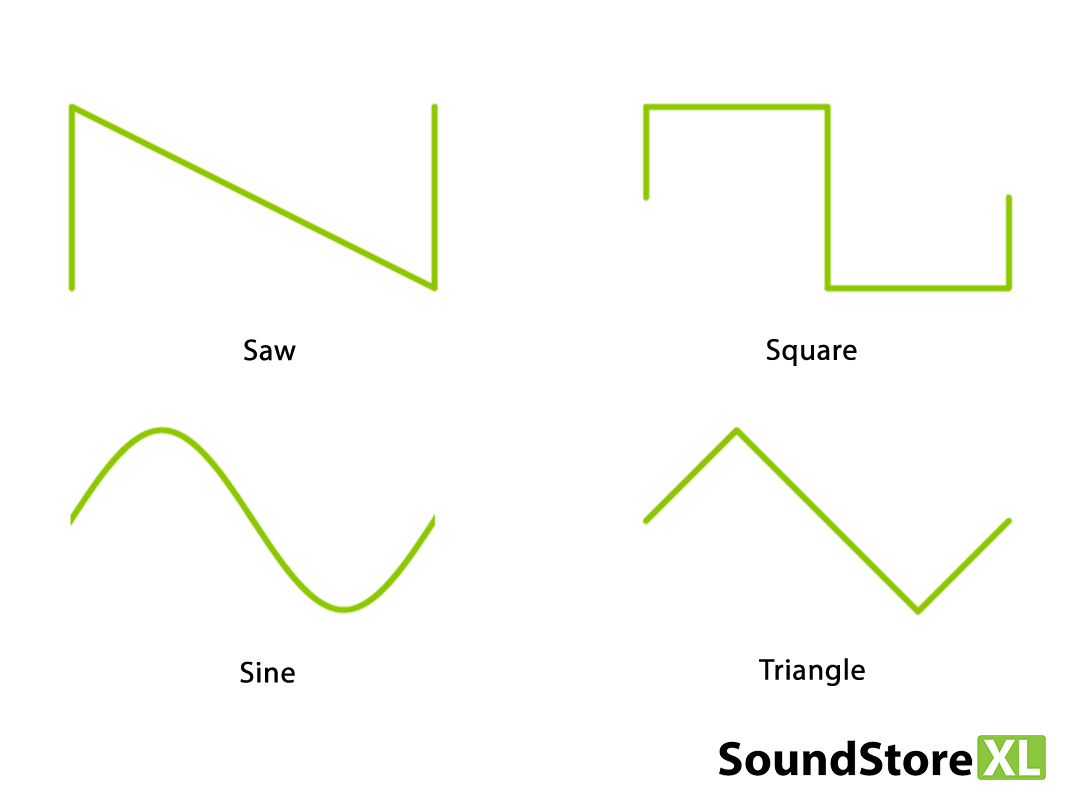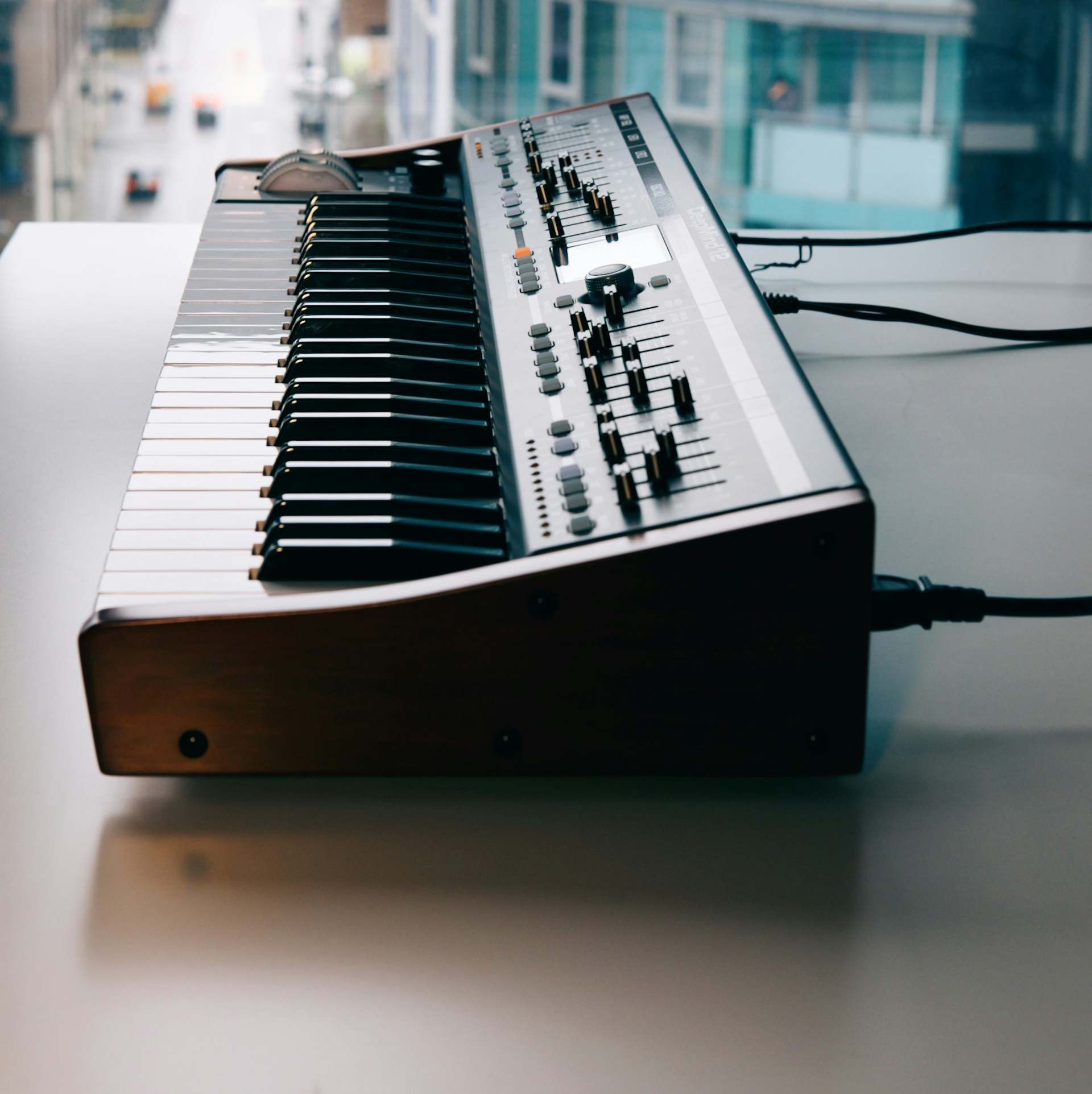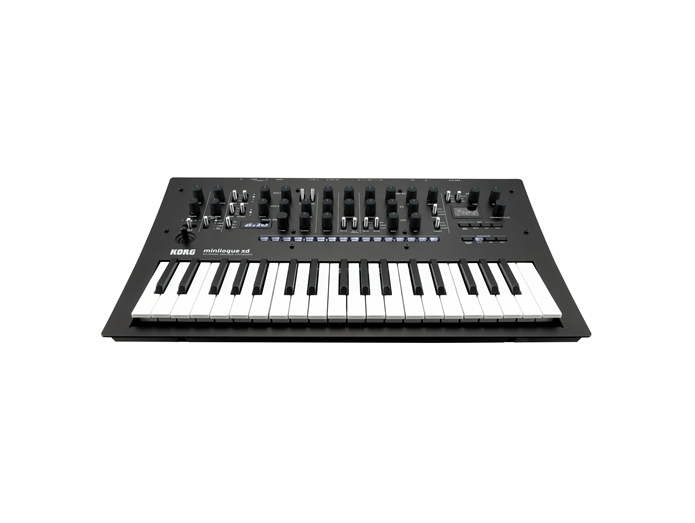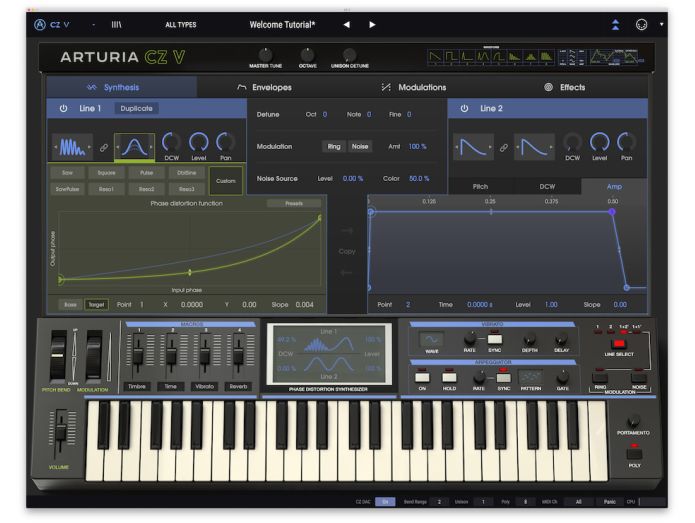They have defined the sound of the 80s, 90s, and are almost impossible to avoid today - synthesizers. Whether it's grand chords in 80s pop, wobbling basslines in dubstep, or heavy 808s in hip-hop, it can all be created with the right synthesizer. That's why today we'll take a closer look at what synthesizers are all about!
The History of the Synthesizer
In the middle of the 20th century, synthesizer-like instruments began to emerge - albeit in very primitive forms. The very first versions were built from vacuum cleaner hoses and used punch cards as data for what to play.
Throughout the 1960s and 1970s, various synthesizer manufacturers began to refine the technology in synthesizers. Especially brands like Moog and Buchla were responsible for developing some of the techniques and components still used today!
In the 1980s, synthesizers took a huge leap! The MIDI standard was introduced, and Yamaha publicly released their DX7, which is now considered the first commercially successful digital synthesizer. At the same time that MIDI and digital synthesizers gained popularity, the form and functions began to resemble what we know today. The possibilities of creating one's own presets and polyphony were becoming standard, while the size of a synthesizer had been considerably reduced, making them easy to move around or take on stage.
In the late 90s and early 00s, software companies began developing the first software synthesizers. These virtual instruments allowed even people who weren't in large studios to have access to plenty of different synthesizers and drum machines with a click of a mouse.
In 1999, Steinberg introduced the VST (Virtual Studio Technology) system, which allowed using a software synthesizer as a plug-in directly in one's DAW. This is still the VST system used in the majority of DAWs today to run software instruments.
Today, synthesizers come in all sizes, shapes, and with different uses. They are found in every studio, if not physically, then as software functions, and new updates and models are being developed faster than ever!
Analog Synthesizers
Analog synthesizers are extremely complex instruments with many components that interact with each other to produce the desired sound.
Basically, when you press a key or send a MIDI signal into the synthesizer, it generates an electrical signal with a specific frequency. This frequency is measured in Hertz (Hz), as we also know it from audio frequencies.
In an analog synthesizer, this frequency is routed through various modules that affect the electrical signal, which ultimately comes out of the synthesizer's output as an audio signal that can be read by your DAW, allowing you to further process the sound.
Analog synthesizers are still a super popular choice today. They are known for their natural, warm sound, often associated with favorite synth-pop bands from the 80s and 90s. However, due to their complex construction and many components, they are also expensive. In fact, analog synths often maintain their prices, even though they have many years under their belt, and some even consider them collectibles.
Modular Synths
Some synthesizers come as an "all in one" solution, while others you can build and modify as you wish. In a so-called modular synthesizer, you purchase individual modules, or building blocks if you will, for the synthesizer and connect them via cables from one module to another. This way, you have 100% control over the order in which the signal passes through the various components, giving you full control over your sound.
Digital Synthesizers
Where analog synthesizers use the electrical signal to create sound, digital synthesizers work somewhat differently. Digital synthesizers do not use filters and electrical components to affect the sound. Instead, the sound is calculated by computer chips, so when you press a key, it's not an electrical signal being processed. Instead, it's a calculation and emulation of how an analog system would process the sound when you add different effects.
Digital synthesizers offer the opportunity to create sounds and other effects that wouldn't be possible on an analog system, but it comes with a "price." Like everything else created by a computer, it's very precise and doesn't have the same "warmth" and naturalness found in analog synths. However, today there are digital synths that come very close to creating "analog" sound. Additionally, digital synthesizers are often much cheaper than analog synths, making them a popular choice for many!
Virtual Synthesizers
As we enter the year 2022, everything is increasingly available as software, and synthesizers are no exception. In fact, virtual synthesizers may be the most popular version of synthesizers today. As mentioned earlier, Steinberg made it possible through their VST system to use virtual instruments and effects as plugins directly in your DAW. This means that instead of having 30 different synths at home, you can now simply have them as software on your computer.
The way a virtual synthesizer works is very similar to a digital synth. The sound is created virtually and calculated by the computer. Virtual synthesizers have the same advantage of not being limited by electronic components, and today, one synthesizer may be enough to create all the sounds you need. However, like digital synthesizers, they lack a bit of the warmth and naturalness of analog synths, although significant advancements have been made in this area in recent years.
Where virtual synths have their great advantage is that everything is possible in software. You can easily download new sounds, update your instruments, and they are cheap. Since software instruments, for obvious reasons, don't have the costs of hardware parts of a synthesizer, they can often be sold quite cheaply. Even the most popular virtual synthesizers like reFX Nexus or Native Instruments Massive can be acquired for around 2,000 kr. in comparison to a digital synth, which can easily cost 2-3 times as much!
Keys or Not - Does It Make a Difference?
When you're looking at synthesizers, you may have noticed that they don't all come with keys. It's a bit different how various manufacturers approach this. Essentially, the keys are not part of the synthesizer itself. The sound processing has nothing to do with the keys. Often, manufacturers actually offer both versions, with and without keys.
MIDI
Now you're probably thinking: "But how do I play the synthesizer if there are no keys?" The answer to this is MIDI, MIDI keyboards, and controllers. MIDI stands for Musical Instrument Digital Interface (thank god for the abbreviation) and is a standard that allows the digitalization of information about keystrokes on a keyboard. MIDI files contain information about pitch, velocity, sustain, pitch, pan, and much more.
MIDI makes it possible to play on a synthesizer or drum machine without it having keys itself. A MIDI track can almost be likened to the paper roll in an old piano from a western movie, playing by itself. When your DAW detects a MIDI note, it plays the corresponding pitch.
Various Types of Keys
If you want to get a synthesizer with keys, there are plenty of those available as well. However, just like with a regular keyboard or digital piano, the keys come in many different versions.
A synthesizer is not primarily intended as an instrument to be played. That is to say, they are often not an instrument you would play for many minutes at a time like you would with a piano, for example. Therefore, they often come with regular non-weighted keys. These are fine for playing chords or melodies, but if you're looking for a true piano/keyboard feel, you'll only get that in the more expensive models. In some models, the keys are even completely replaced with black and white buttons to replace the regular keys.
Understanding Different Concepts
When you first look at a synthesizer, it can seem quite overwhelming. There are lots of buttons, faders, knobs, and other things that all have different names. But fear not, below I have compiled a small collection of words and concepts for you!
Oscillator: Sine, Triangle, Saw, Square
One of the first things you'll encounter when designing a sound on your synthesizer is the concept of "Oscillator." The oscillator dictates how your synth generates sound. The ones you'll most often come across are Saw, Square, Sine, and Triangle. Each shape has its own characteristic sound, as they generate sound in different ways.

Below is a list of some of the most commonly used filters and envelopes:
Attack: Attack refers to how long it takes for the sound to reach its full strength after the key is pressed.
Decay: Decay describes how long it takes for the sound to decay from its peak level to the sustain level.
Sustain: Sustain is the level or strength that the sound will hold if you hold the key down.
Release: Release is how long it takes for the sound to disappear after you release the key.
Cutoff: Cutoff is used, as the name suggests, to cut certain frequencies. Often, cutoff will cut the high frequencies, but some synthesizers have both hi-cut and low-cut.
Pitch: Pitch determines how dark or light the tone you play is. This can be used for effects such as pitch bends, which are quite popular!
Noise: Noise adds noise to your sound. The noise is often white noise, which many are familiar with, and is triggered along with the keys and follows the rhythm of the played melody.
I hope that with this article, you've gained a better understanding of the synthesizer and realized that it's an incredibly versatile instrument. There are endless possibilities for creating sounds, and experimenting with it is never boring. Whether you prefer software or hardware synthesizers, only your imagination sets the limits for what you can achieve!







→ Back to our Information Center ←
Terms and conditions for private clients
Click here to see our terms and conditions for business clients
Music Group Denmark A/S and this e-commerce shop will be referred to as "seller, us, we, our, the webshop", while the client purchasing a product from Music Group Denmark A/S will be referred to as "buyer, client, customer, you, your, yours”.
Address:
Music Group Denmark A/S
Norddigesvej 4
DK-8240 Risskov
DENMARK
info@soundstorexl.com
Tel. +45 70273041
Private company
VAT: DK-33777175
Year of establishment: 2011
Delivery
The delivery costs depend on the size and weight of the order as well as the address and country of its destination. Please visit our Information Center for an updated country-specific price list. We reserve the right to charge the actual shipping price in case of goods exceeding the carriers' standard size and weight restrictions. We will inform the customer about this before the order is completed.
You have the option to enter an alternate shipping address, e.g. your workplace, when placing the order.
The sender of the package will be our logistics provider Online Distribution.
Please note:
When you order goods for private delivery, the order can be delivered by one or more carriers due to the fact that our suppliers use different freight companies. Packages will be handled according to the company’s method of conveyance.
You can find a list of our carriers in our Information Center. If you would like to know who will be delivering your order, in most cases you can find the information on Your Account. If this is not stated, please feel free to contact us.
Payment
In our e-commerce store you can pay with the following means of payment:
Credit cards
MasterCard
MasterCard Debit
Maestro
Visa
Visa Electron
The amount will not be drawn until we ship your order and we cannot draw a larger sum than the one you approved at the time of purchase.
Bank transfer
Please transfer the total order amount (including the delivery fee) to our bank Spar Nord Bank A/S:
BIC/Swift code: SPNODK22
IBAN: DK2290041120451932
We will charge no fees for banktransfers.
Gift certificate
Please note that you can only use one gift certificate per order.
For information on other country-specific means of payment, please click here.
When we have received the payment, we will ship your order immediately.
Prices
We reserve the right to cancel an order due to incorrect pricing in our e-commerce store (this might occur due to automatically calculated prices). The automatically generated confirmation, you will receive upon placing your order, is thus simply a copy of the online shopping cart - not our final order confirmation.
It is possible for you to view your previous orders in our online shop (starting from when you created a login with us). After logging on you can print your invoices etc.
Please note that both Danish and international private clients will be charged VAT according to Danish legislation.
Terms and conditions for discount codes and gift certificates
Unless stated otherwise, the following terms apply to the use of discount codes when placing a regular order (not applicable to individually prepared offers).
1. A discount code can only be used once per customer per day.
2. You cannot use more than one discount code per order.
A gift certificate is considered a deposit, not a product purchase. A gift certificate cannot be used as payment for a new one.
Right of return/cancellation
When shopping with us, you have 30 days right of cancellation. It expires 30 days after you:
When returning a product to us, please download our return form, fill it in and include it in the package.
Please note that some goods cannot be returned as normal cargo due to their size (this usually applies to goods over 30 kg or 2 meters in length).
You cannot cancel an order just by refusing to accept delivery without specifically letting us know.
Goods not included in the right of return/cancellation
We do not accept the return of demos and goods that have been made or ordered specifically for you (e.g. items that have been shortened according to your instructions or custom-made items). Furthermore, we do not accept the return of certain product categories, as it is impossible to assess the extent to which they have been used: pickups, pickup needles, bulbs, liquids, paint etc.
Return policy
Please use this return address:
Music Group Denmark A/S
Norddigesvej 4, Gate 6
DK-8240 Risskov
DENMARK
Please note that it is not possible to send us the goods COD.
We only accept products returned in their original packaging and only if the included software is not enabled. This means that when we receive the returned products, they must always be in minimum the same condition as when we shipped them. Therefore we kindly ask you to make sure that the item is properly wrapped. Since you are responsible for the goods until we receive them, we encourage you to keep your track and trace number from the carrier.
Please include a copy of the order confirmation or other documentation for your purchase when returning the item to us.
Please note that you are responsible for covering the shipping costs when returning a product to us.
In cases where the right of cancellation is used, we refund your purchasing price plus the delivery costs (if you had any when the goods were delivered to you) as soon as possible (and no later than 30 days from the day we received notification of your decision to cancel the order).
Please note regarding returned goods:
We always check goods returned to us, and you might lose your payment in part or in full. This happens if a product has been damaged or its value has been reduced. Among other things this could be the case for one of the following reasons:
Refund:
We make the refund with the same means of payment that you used for the original transaction unless we have explicitly agreed otherwise. If you paid with credit card, we will transfer the money back to the same card.
We can withhold the payment until we have received the returned item from you (unless you have submitted documentation for returning it). We refund the amount that you paid for the goods as soon as possible (and no later than 30 days from the day we received notification of your decision to cancel the order).
Read more about the cancellation of orders paid with MasterCard and Visa Card.
If the product is faulty (right of complaint)
When you shop in our e-commerce store you are protected by Danish legislation offering a high level of consumer protection. You have 12 months warranty and 12 months right of complaint which allows you to submit a complaint about errors or omissions that existed when the item was sold.
We do not provide support or warranty on free software (e.g. a trial or limited edition). The manufacturer provides the software support.
It is a requirement that the complaint is justified and that the defect has not arisen as a result of an incorrect use of the product or other damaging behaviour.
Please have a look at our Information Center for answers to frequently asked questions regarding this.
You are also very welcome to contact us. Depending on the specific situation we can tell you where the burden of proof lies, if the goods can be repaired or exchanged or if a discount can be an option.
Repair
If an error occurs with a product within the warranty period (12 months warranty from date of purchase + 12 months right of complaint), please contact us with a detailed description of the issue. Then we can arrange the details of the repair before you ship it.
Sending the product for repair consists of the following steps:
Fill in our online RMA form (repair form) to help us minimize the turnaround time.
Send it to us.
Await our answer regarding repair.
Send the product according to our instructions. We might ask you to send the product directly to the manufacturer to shorten the expedition time. Please note that it is not possible to send the goods COD.
When sending the package you MUST enclose:
An address to which we can return the product after repair
A list of the equipment included in the package, e.g. power supply
A copy of the original invoice (can be found in your customer account)
We will then get back to you as soon as possible.
Repair terms and conditions
The product must be sent securely wrapped, at best in its original box.
In case the stated error cannot be observed, or if the error has been caused by another product, an inspection fee of €55 including VAT is charged by invoice. The amount must be paid before the product can be returned to you.
Please note that you are responsible for covering the shipping costs when sending a product for repair. We pay the costs when returning the product to you after repair (only for private clients and only if the repair is covered by the warranty or right of complaint).
Personal Data Protection Policy
In order for you to enter into an agreement with our e-commerce store, we need the following information:
We solely register this personal information in our system for the purpose of processing your order.
No personal information recorded on our webshops will ever be transferred, sold or made available to third parties. All information is stored in a secure manner and is only available to our trusted employees.
Our e-commerce store has a highly encrypted and secure system for online payments to guarantee your safety when shopping with us.
The webshop system uses so-called cookies to manage the content of your shopping cart. In short, a cookie is the name of a file stored on the buyer's computer. We use these cookies to recognize customers and, for instance, remember what items are in the shopping cart when you shop with us. It is also possible for you to ask the system to store your contact details for your next visit. If you ever want to erase the information stored via cookies, this can be done in the browser settings. In Internet Explorer, for instance, please go to the "Tools" menu and then choose "Internet Options".
In addition, we register the IP address from which the purchase is made. This information is normally not used, but can be used in the case of a police investigation. The IP address is stored as long as necessary in relation to the police investigation. All fraudulent orders will be reported to the police!
According to Danish legislation the personal data are registered with Music Group Denmark and stored for five years after which the information is deleted.
When collecting personal information through our website, it is always done with your preceding consent. In that way you always know which information we have and why.
Our managing director and customer service employees have access to the information that is registered about you. The managing director of Music Group Denmark, Palle Bertelsen, is our systems manager.
When you are registered with Music Group Denmark A/S, you are always entitled to object to the registration. According to Danish legislation you also have the right to insight in the information we have on you. Please contact Music Group Denmark on info@soundstorexl.com regarding this matter.
Log entry
We use log statistics on our e-commerce store, which means that our system collects information that can give us statistics on e.g. the number of visitors, where they come from and where on our shop they drop out. Log statistics are used only for the purpose of optimizing our online shop.
You can choose to have your email address included on our mailing list. After registering you will regularly receive news and other information regarding our e-commerce stores. You may subscribe or unsubscribe this service at any time.
When you are registered with Music Group Denmark A/S, you are always entitled to object to the registration. According to Danish legislation you also have the right to insight in the information we have on you. Please contact Music Group Denmark regarding this matter:
Music Group Denmark A/S
Norddigesvej 4
DK-8240 Risskov
DENMARK
VAT: DK-33777175
Tel.: +45 7027 3041
info@soundstorexl.com
Complaints
If you want to complain of your purchase, please contact our customer service at info@soundstorexl.com or telephone +45 70273041.
→ Back to our Information Center ←